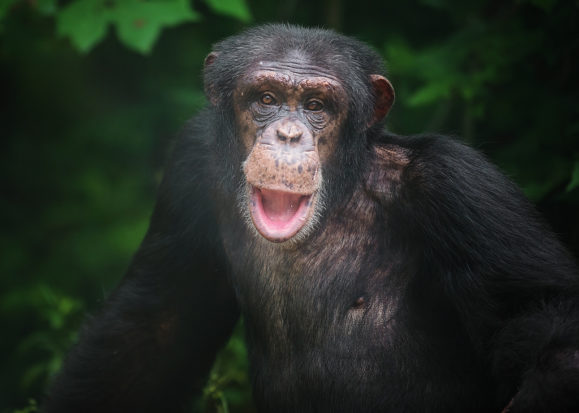
After dinner we were treated to an impromptu performance by Leo, pictured above, who danced around, drumming on everything in his enclosure. He kept time and beat perfectly. Photo by Crystal Alba/Project Chimps
I arrived at Project Chimps yesterday just as dinner was being served to its residents: 79 retired research chimpanzees who now call this verdant, 236-acre sanctuary nestled in the Blue Ridge Mountains in Georgia their home.
The building we were in is a brand-new, state-of-the-art structure named the Laurie and Carlee McGrath Chateau, after the two generous donors whose funding and support made it possible, and it is the fifth and largest chimpanzee house at the sanctuary, with room for 40 chimpanzees. There are already 14 residents at the Chateau and, contrary to what I had expected, they were an incredibly patient lot at dinnertime. At home, mealtimes with my dog Lilly and cats Misti and Storm are an enthusiastic affair, so I assumed there would be lots of jockeying among the chimpanzees for the best position, and some pushing. Instead, the animals waited calmly for their turn, apparently aware of the order and pace of the caretakers serving their meal. They didn’t all clamor to the front of their enclosures, and even appeared to know who got what and when. When dinner—nutritional biscuits, vegetables, fruits and a frozen pumpkin smoothie for dessert–was served, they ate quietly and happily.
We were even treated to an impromptu after-dinner performance by one of the chimpanzees, Leo, who danced around, drumming on everything in his enclosure. He kept time and beat perfectly.

What made my trip even more special this time was that I was here with Laurie McGrath and her mom, Carlee, who, at 94, traveled from California to see the chimpanzees. Also pictured, on the right, Ali Crumpacker, executive director of Project Chimps.
My job as president and CEO of the nation’s most influential animal protection organization takes me into nearly every type of situation involving animals, from the heartbreaking to the heartwarming. Being here, at Project Chimps, which is supported by the Humane Society of the United States, definitely falls in the latter category. What made my trip even more special this time was that I was here with Laurie McGrath and her mom, Carlee, who, at 94, travelled from California to see the chimpanzees.
We toured the sanctuary, which opened five years ago, and its many facilities designed with the comfort and care of its very special residents in mind. There’s the six-acre Peachtree Habitat, a lush, forested area with no caging overhead, where the chimpanzees can forage, climb and play, exactly like they would in the wild. They spend their time eating, laying in the sun and sleeping. At the sanctuary’s veterinary hospital, staff and volunteers conduct careful scientific observations of the chimpanzees to monitor their behavior and use of the enrichment tools offered, and also work to promote the animals’ successful social integration.
The Chateau is a 5,600-square-foot building and in addition to the bedrooms for the chimpanzees, it has climate-controlled, large group enclosures and an open-air enclosed porch. It was built at a cost of $ 1.3 million. Among the animals who have already moved in are Hercules, who was only two when he was leased to a New York lab where he and his group mate at Project Chimps, Leo, were forced to walk upright in a study of locomotion. Then there’s Kareem, a gentle giant who arrived at Project Chimps after spending 29 years in various labs.
The HSUS led a decades-long fight to end the isolation and suffering of chimpanzees like Hercules, Leo and Kareem in laboratories. In 2015 our efforts led to the United States government’s announcing that it would list all chimpanzees as endangered under the Endangered Species Act, effectively ending all invasive chimpanzee research in the country. Helping Project Chimps is part of our commitment to ensure that the animals coming out of such research have a place to retire peacefully.
The sanctuary is the result of an agreement negotiated between the founders of Project Chimps and the New Iberia Research Center, which houses the largest population of privately owned chimpanzees, to transfer its entire population of animals to lifetime sanctuary care. The completion of the Chateau will allow Project Chimps to bring an additional 40 chimpanzees to permanent retirement from the NIRC. By the time all animals move in, the sanctuary will house more than 200 chimpanzees.
It was with a heavy but full heart that I said goodbye to the beautiful animals of Project Chimps this afternoon. There are lots of plans for the sanctuary in coming years, and already I am looking forward to my next visit. A second phase expansion to build new chimpanzee habitats and housing from the ground up is now underway. As we work toward our shared goal of retiring all 200 chimpanzees at NIRC to Project Chimps, we continue to look forward to your enthusiastic support and commitment to help make this important dream come true. Please give generously for these animals, so they can spend the rest of their days in peace and comfort, far from the horror and memory of life in a research lab.
The post New building makes room for more chimpanzees to retire at Project Chimps appeared first on A Humane World.
Enviroshop is maintained by dedicated NetSys Interactive Inc. owners & employees who generously contribute their time to maintenance & editing, web design, custom programming, & website hosting for Enviroshop.
